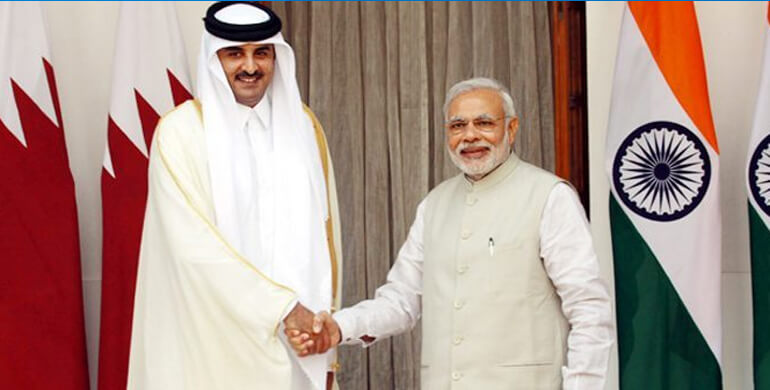
15 March, 2025
INDIA’S GULF STRATEGY AND ROLE OF QATAR
- Brig. R.K Gupta (Retd)
1. Exception to Diplomatic Protocol for Qatar’s Amir.
Protocol, on who should receive visiting Heads of State is well established. It is usually a Cabinet Minister, Minister of State or even a Secretary in the Government who welcomes them. The Prime Minister of India receiving a Head of State is an exception and considered a special diplomatic gesture. PM Narendra Modi made such an exception by personally receiving the Qatari Head of State, Sheikh Tamim bin Hamad Al-Thani, during his visit to India on 17–18 February. This underlined the strategic importance India places on its relationship with Qatar. During this visit a Strategic Partnership Agreement and several Memorandum of Understanding (MoU) were inked. Modi’s personal rapport with Qatar came to the fore in his previous visits when the highest Qatari honour was conferred upon him. India and Qatar share a long-standing defense cooperation agreement, also.
2. Resolution of the Indian Navy Officers’ Case.
Despite strong bilateral ties, an incident involving the arrest of eight former Indian Navy officers by Qatar on alleged espionage charges had strained relations. However, their pardon by the Amir highlighted the nature of interpersonal diplomatic ties between PM Modi and the Amir of Qatar.
3. Personal Diplomacy in the Gulf.
In the Gulf and Arab world, personal relationships play a major role in diplomacy. Frequent high-level interactions in the recent past have helped India build strong partnerships. and India has transformed transactional relationships into deeper, long-term strategic partnerships.
4. India’s Support During the Qatar Blockade.
India has consistently championed diplomacy and dialogue in resolving international disputes. This was evident during Qatar’s four-year-long blockade due to its support to terrorist groups, by neighbouring Gulf states. Despite the blockade, India maintained trade ties with Qatar and supplied essential goods. Today, bilateral trade fluctuates between $10 billion and $14 billion, with a goal to double it by 2030.
5. Indian Businesses and Workforce in Qatar.
During the blockade, Indian businesses, both large and small, stepped in to support the Qatari economy, particularly in alleviating shortages. Indian workers and companies continue to play a significant role in Qatar’s development, reinforcing the depth of India-Qatar economic ties. Both nations have also decided to explore a Free Trade Agreement (FTA) to enhance trade and investment.
6. Expanding Trade Agreements and Banking Integration.
India benefits from a Comprehensive Economic Partnership Agreement (CEPA) with the UAE, which has yielded significant gains. Using CEPA as a model, India is actively negotiating an India-GCC FTA. Financial integration is also being strengthened, with Qatar adopting India’s Unified Payments Interface (UPI) and establishing a Qatar National Bank branch in India to facilitate trade, tourism, and investment. On its part, India has extended its e-visa facility to Qatar, easing business and travel further.
7. Qatar’s Role in India’s Energy Security.
As India’s leading energy partner, Qatar supplies over 70% of India's Liquid Natural Gas (LNG) and Compressed Natural Gas (CNG) imports. A landmark 20-year deal, signed last year, ensures the continued supply of 7.5 million tonnes of LNG and CNG annually from 2028 onward, valued at $78 billion. This aligns with India's Viksit Bharat 2047 initiative and its climate commitments.
8. Increasing Qatari Investments in India.
Although Qatari investments in India remain modest at $1.5 billion, a recent announcement of an additional $10 billion investment in infrastructure marks a significant step forward. The sectors targeted include technology, manufacturing, food security, logistics and hospitality. Invest Qatar and Invest India have signed an MoU to facilitate investment flows.
9. Enhancing Economic and Financial Oversight.
The signing of the updated Avoidance of Double Taxation and Prevention of Fiscal Evasion Agreement ensures a more structured approach to financial governance. The agreement allows real-time information exchange between finance ministries, boosting transparency and investor confidence.
10. Collaboration in Technology, Food and Digital Sectors.
India and Qatar are expanding cooperation beyond traditional sectors, particularly in Artificial Intelligence (AI), cybersecurity, space and e-governance. Indian startups are also being encouraged to participate in upcoming web summits in Doha, reflecting a growing digital and technological partnership.
11. Joint Efforts Against Terrorism and Extremism.
An important agreement signed during the visit was a commitment to combat terrorism in all forms, including cross-border terrorism. Concerns have been raised about extremist groups allegedly receiving indirect support through charities operating in the Gulf, including Qatar. Both sides agreed to enhance intelligence-sharing to counter extremism and radicalization.
12. Respect for Mutual Sensitivities.
As the world’s third-largest Muslim-majority country, India remains mindful of the sensitivities of Islamic nations. In return, India expects its strategic partners to demonstrate similar awareness and consideration toward India's security and interests.
13. Qatar’s Expanding Role in Global Diplomacy.
Qatar has positioned itself as a key diplomatic player in the region, actively mediating global conflicts, including those involving the Taliban in Afghanistan and the Hamas-Israel conflict. Qatar also maintains strong relations with Tehran and hosts major U.S. and Turkish military bases, further solidifying its influence.
14. India’s Engagement with Qatar in Regional Affairs.
The visit of the Qatari Head of State, Sheikh Tamim bin Hamad Al-Thani, provided a crucial platform for India to gain insights into regional conflicts while reinforcing bilateral cooperation. Under Qatar’s leadership of the GCC, the India-GCC Foreign Ministers’ Dialogue has been initiated, alongside a Joint Action Plan. A high-level bilateral mechanism between the two foreign ministries will further strengthen India’s strategic footprint in the Gulf region.
